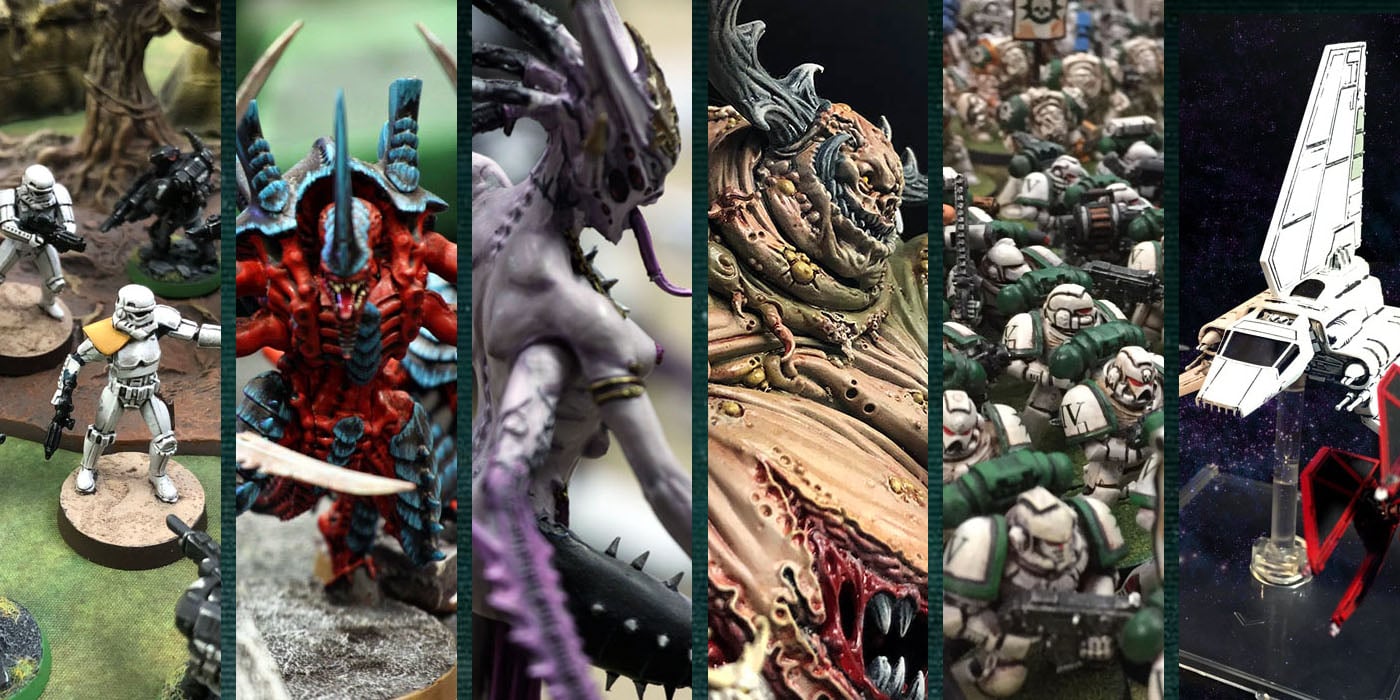40k: Making Units BOTH Unique and Effective

This article deals primarily with designing units for 40k that are BOTH good in terms of performance and also unique. Lets forge ahead.
There is lots of information available on the Internet that covers what are good units but I often find this type of information tends to be repetitious. We all know just how good are IG veterans, Purifiers and Grey Hunters – no one can deny these are good units plus they are well costed in terms of what you get for the points. The same can be said for BA assault squads and even DE Wyches. There are common templates available for these types of units right at the end of your fingertips and you don’t often see too much deviation from the norm. For the most part I am going to steer clear of these in this article – like I said there is already a world of information available – it is common knowledge. I would instead like to explore other units that tend to be overlooked in 5th edition and also show a few alternate approaches to a couple of commonly fielded units as well.
To me one of the major advantages when fielding units that are less popular from a competitive point of view is that other players will tend to have a hard time deciding how to effectively deal with them due to their lack of experience versus them. For example how many times have you faced off against an Ork army with Tank Bustaz or Flash Gitz? Typically at a tournament it’s one and you’re done – you play versus a certain player once then move on to the next opponent. How often have you played a game where at the end you ended up losing and couldn’t help thinking if you had it to do over again you probably could have won knowing what you learned during your loss? I think there is more to this type of approach than what might at first appear on the surface as an unusual aberration. For example it is commonly stated on the Internet that infantry heavy Eldar armies are gimped but in fact in the hands of a skilled player they have actually done quite well. I know to a few I’m preaching to the proverbial choir but remember this article is tailored towards those who might like to learn something new.
Overall Army Design and Coordination Between Individual Units
I’m not espousing the design of a gimmicked army list – a major problem with this approach is that at a large tournament (five or more rounds) one trick ponies often end up playing against another army that is the paper to their rock. I’m really all about building highly balanced armies that have what I think are the three most important aspects:
— Mobility
— Effective shooting versus infantry and armor
— Effective melee versus dedicated close combat units (e.g., assault terminators)
If you want to build an effective army composed of several or more unique units you will probably have to design it such that there is a lot of synergy between the various units… Probably you won’t be able to rely upon a couple of rock units to thoroughly trounce your opponents. This type of army design means that you will need a lot of coordination between your individual units.
First Two Examples – Tyranids versus Space Marines
Here is my first example – I’m playing my Tyranids versus a Space Marine army that has a big squad of assault terminators armed with lots of thunderhammers and stormshields. The terminators are guarding a flank I need to penetrate so I can reach the softer enemy units hiding behind them. Here is a synergistic approach to handle them – first focus fire on the terminators – even if I only kill one or two that will make the ensuing assault more manageable. My Hive Tyrant then casts paroxysm on the terminators reducing their weapon skill to WS1 then I assault them with a large brood of genestealers. The genestealers are armed with toxin sacs and scything talons – so I reroll to hit on 1s and reroll to wound as well – this combination of wargear generates a lot more rends. Note that with scything talons you will roughly reroll half of your missed hits since you are hitting the terminators on a 3+. The Broodlord also casts Hypnotic Gaze on the terminator sergeant to prevent him from swinging back. If everything goes as planned at most there are only a couple of terminators left and due to the low number of attacks plus they are hitting back on 5+ I only lose at most a couple of genestealers and if need be I can soak one wound on the Broodlord. The terminators lose combat and are then destroyed the next round of close combat thus protecting my genestealers from being fired upon during my opponent’s subsequent turn. There are a lot of elements to this combined approach and you can’t count on everything working in your favor… For example if there is a Librarian close by in the Space Marine army he might be lucky and cancel both of the Tyranid psychic powers with his hood. On the other hand the Space Marine player has nothing in his arsenal to fully negate my focused fire and there is nothing he can do to thwart the genestealers’ wargear (toxin sacs and scything talons). If the majority of these combined tactics work then most likely the end goal is satisfied barring a lot of really awful dice rolls.
Genestealers are currently considered nerfed since they no longer have access to assault grenades. Some people are under the impression that genestealers can’t even effectively tackle a squad of tactical Marines sitting in cover. That is a gaming myth though if you stop to think about it. For example assume a brood of 10 genestealers armed with toxin sacs launch an assault into a squad of 10 tactical Marines sitting in cover – I’ll even play the odds in favor of the Space Marines… Not that you’d think they need it but it helps to drive the point home. Let’s assume the sergeant has a power fist as well. The nine tactical Marines strike first – 9 attacks generate five hits and three wound – two genestealers die as a result. The eight genestealers then strike back – 24 attacks – 16 hit, eight wound and one of which is a rend. The genestealers then reroll the failed wounds and generate four more wounds, one of which we will assume is another rend. The tactical squad loses three Marines to failed armor saves and two more from the rends for a total of five dead. Assume the sergeant survives and then finally swings back with two attacks killing another genestealer – the genestealers win combat by a margin of two wounds for roughly an equal cost between the two units and if the remaining tactical Marines break they will most likely be caught by the genestealers due to their higher initiative (+2).
These first two examples help to illustrate why genestealers can actually be more effective than most might think. Of course there are lots of external factors I did not consider but if we take these two examples as just that I think it helps proves what I’m getting at here.
Third Example – Dark Eldar Trueborn
We all know the current meta build for this unit – a squad of five Trueborn with four blasters riding in a venom with dual splinter cannons. You can take up to three of these units and it’s a very popular build playing into the gunboat theory for designing dark eldar armies… This is totally an MSU type of build. While this is an effective build and well proven it misses some of the other good options available to Trueborn which are in many ways the Sternguard of the dark eldar. If you stop to think about it few if any other eldar units have access to as many options as the Trueborn and they can indeed fulfill multiple roles.
Here is how I run mine:
Drachon – blast pistol & agonizer + phantasm grenade launcher
3x Trueborn w. shard carbine
1x Trueborn w. splinter cannon
4x Trueborn w. blaster
Raider w. dark lance & flickerfield
The unit of Trueborn armed as such can pop armor and are also good at spewing out anti-infantry with the large number of shooting attacks coming from their ranged poisoned weapons. The Drachon armed with the agonizer can finished off wounded monstrous creatures and tough ICs. At first glance this build might seem like its all over the place – a master of none while at the same time attempting to be a jack of all trades… However I have found them to be very effective fielded as such and they are one of my favorite units in my dark eldar army. I’m not advocating that this is a better approach to running your Trueborn – it simply serves as an example to show how you can uniquely and effectively field one unit that has been painted into the proverbial corner when it comes to designing dark eldar armies. Their main weakness is they are fragile to incoming firepower (just as is the case with the standard build) so you have to protect them well to get back their points. This approach is a lot more fun for me to play them and that’s just as important to me as fielding a competitive army. Sure they cost a lot more designed as such but that in and of itself does necessarily mean it is not effective or a bad choice.
Final Example – Bloodcrushers versus Dreadnaughts
Here is another Internet myth – Bloodcrushers cannot effectively handle dreadnaughts in melee. Let me say up front my daemon army is comprised solely of Khornate units except for one winged Nurgle daemon prince… As such I’m willing to pay the points to make my Blood Crushers very effective versus just about any unit except for Grey Knight units with Dark Excommunication – there’s no way I am aware of to currently get around that one obstacle other than kill it with other units. I knew that dreadnaughts can be a real problem since Blood Crushers have a problem dealing with AV 12|13 in melee.
My solution was as follows – I have a unit composed of four Blood Crushers (one armed with Fury of Khorne) and they are joined by four Khornate Heralds mounted on Blood Crushers – one of which is the Skulltaker while the other three have Unholy Might and Fury of Khorne amongst other very evil daemonic things. Equipped as such the combined unit could and did quickly cut through dreadnaughts like so much tinfoil – even multiple dreadnaughts. I won’t go though all the mathammer to prove my point but like I said I never had any problems versus dreadnaughts and I remember one game versus an Ork Kan Wall army – the combined unit of Heralds and Blood Crushers mowed right through them all in a couple of turns. Remember that I said my daemon army is Khornate in theme so the points costed for this build was effective versus most any army I came up against – its not like I was designing a one dimensional army that was only effective versus walkers in melee… I wanted to build a more robust army. To me the army has a true theme unlike the popular Fate Crusher spam that was all the rage a few years back.
Closing Thoughts
I have shown four examples here how to build unique units for 40k that are also effective in terms of overall fielding competitive armies. All of the armies I mentioned here have performed well in either|both local and national events. I think it’s possible to design armies that have a unique theme which fits into their background while also being competitive. If you simply want to copy Internet meta lists that are well proven that’s all well and good – there is nothing wrong with that approach. If however on the other hand if you want to venture away from the norm you can still be successful if you are willing to give it some serious thought and playtest enough to figure out how to make it all work.
So do you have any unique units you like to experiment with ? If so what non-standard unit is working for you ?







